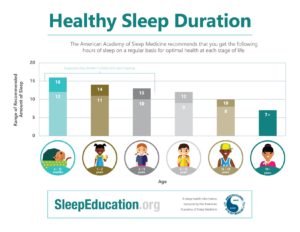A Good Night's Sleep: Tips for School-Aged Children and Adolescents
By: Dr. Joseph Mechak
There are few things more important to your child’s health than a good night’s sleep. Sleep duration, sleep quality, and sleep environment all play a vital role in your child’s mental and physical health. Poor sleep has been linked to thing like behavior problems, anger, depression, anxiety, inattentiveness, hyperactivity, headaches, poor school performance, fatigue, obesity and more [1]. Sleep is often one of the first thing we will talk about if we see you in the office for one of these issues.
The bad news is that our kids aren’t very good at getting good sleep. Studies show that 20% of 8 year olds and 40-75% of 18 year olds do not get the recommended amount of sleep on one or more nights during the week [1,2]. Unfortunately, this problem is only getting worse. Technology and screen time have been implicated in even further reducing sleep time and sleep quality in our children [3].
The good news is we have a few simple strategies that can made a huge difference. Together, we call these strategies ‘sleep hygiene.’ Implementing proper sleep hygiene is a critical first step in improving your child’s sleep. Studies consistently show that these simple interventions lead to consistently earlier bedtimes, shorter time to fall asleep, fewer night time wakenings, and increased total sleep duration! [4].
The key components of sleep hygiene include:
- Bedtime and bedtime routine: Children are creatures of habit. Structure and routine at bedtime help prepare your child mentally and physically for sleep. Having the same bedtime every night, including weekends, helps the body know when it’s time to wind down and prepare for sleep. Similarly, having the same nightly routine sends subconscious signals to the body that sleep time is approaching.
- Sleep Environment – A proper sleep environment will help you child fall asleep and ensure they have good quality sleep. Elements of a good sleep environment include:
- A cool, dark room with no more than a small night light.
- A quiet space that is out of earshot of any ongoing conversations, TV or computer noise, or other environmental noise. Some white noise is fine, but should be played at a low volume.
- A room without temptations. No computers, TVs, phones, tablets or even stimulating magazines/books or activities should be in your child’s room at night.
- A comfortable bed that is used only for sleeping. Try to avoid play or other activities in bed. We want your child to associate his/her bed with sleep, not play.
- Limit stimulation before bed: Avoid stimulating activities like exercise, scary or exciting TV shows, movies, or books, and sugary foods for 30 minutes to 1 hour before bedtime. Ideally there should be no screen time at all for 1 hour prior to bedtime. Not only is the content on the screen stimulating, but the blue light from our devices mimic daylight and keep the brain stimulated and awake.
- Physical activity: Daily physical activity keeps the body and mind healthy and help maintain a healthy balance. It also helps burn energy and tire kids out which in turn can lead to a more successful bedtime.
- Set yourself up for success: Plan ahead. Below are the recommended sleep duration by age. Make sure that your set you child up for success by setting an appropriate bedtime that factors in time to fall asleep. [5]
There is lots of evidence to say these simple interventions can make a huge difference. If sleep remains problematic after implementing these tricks, it may be time to come see us in the office. We can help troubleshoot the problem and may be able to recommend sleep aids like Melatonin (you should talk to us before starting a supplement like this). To help prepare for the visit, making a sleep diary can be helpful. Make note of things like bedtime, how long it took to fall asleep, number of night wakenings along with details about your child’s day, diet, physical exercise, stressors, and anything else that you think may be contributing to his/her sleep problems.
If you would like more information, check out the links below or give us a call to schedule a telemedicine or in-office appointment.
HealthyChildren.Org – Healthy Sleep Habits
HealthyChildren.Org – Bedtime Routines for School Aged Children
HealthChildren.Org – Sleep Tips for Your Family’s Mental Health
References:
[1] J Owens, MD, MPH, FAAP and the Adolescent Sleep Working Group and Committee on Adolescence: Insufficient Sleep in Adolescents and Young Adults : An Update on Causes and Consequences. PEDIATRICS Vol. 134, number 3, September 2014
[2] A Smaldone, DNSc, CPNP, CDE, JC. Honig, DrNP, RN, EdD, CPNP, MW. Byrne, PhD, MPH, FAAN Sleepless in America: Inadequate Sleep and Relationships to Health and Well-being of Our Nation’s Children. PEDIATRICS Vol. 119, Supplement 1, February, 2007
[3] L Hale, PhD, S Guan, MPH, Screen Time and Sleep among School-Aged Children and Adolescents: A Systematic Literature Review. Sleep Med Rev. 21: 50–58 June 2015
[4] JA. Mindell, PhD, et. al, Bedtime Routines for Young Children: A Dose-Dependent Association with Sleep Outcomes. SLEEP, Vol. 38, November, 2015
[5] American Academy of Sleep Medicine, AASM.org











Leave a reply